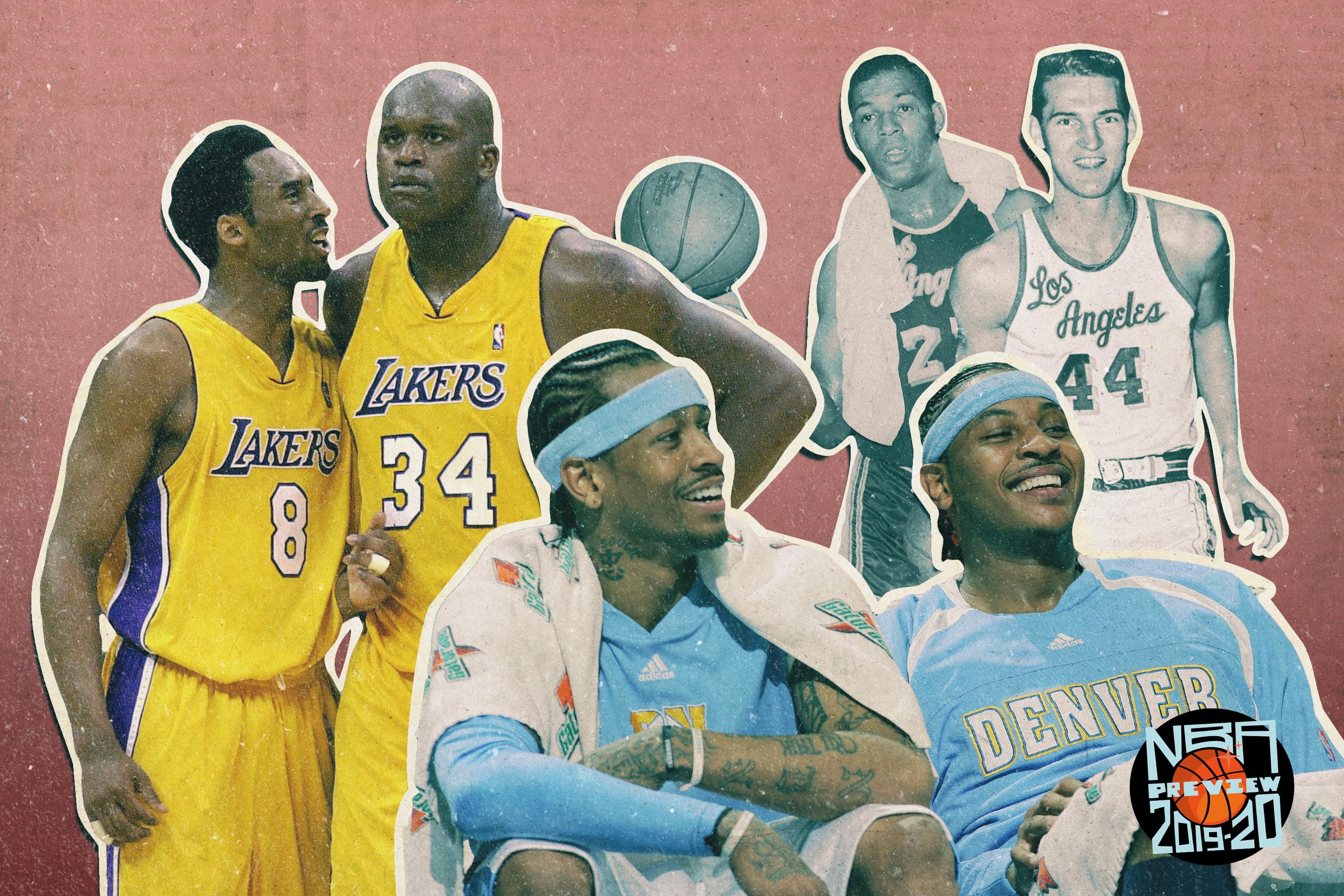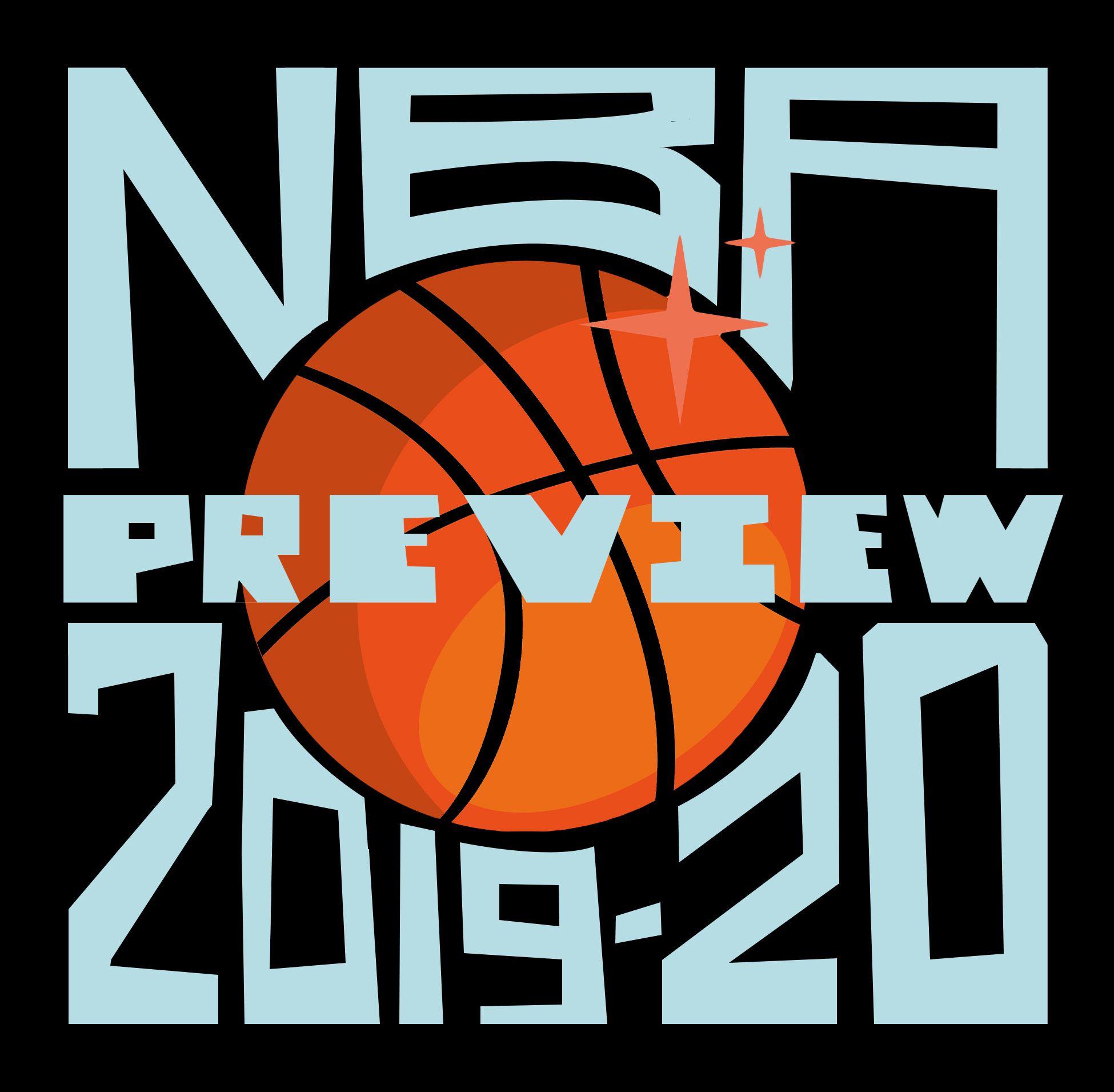The Best Offensive One-Two Punches in NBA History
Some of the league’s most lethal scorers are teaming up this season. Which new Big Twos can keep racking up the points? And do high-scoring duos equal postseason success? We ranked the 20 most productive twosomes ever to find out.The NBA is overrun with Big Twos, or at least that’s how it seems after an offseason full of superstar team-ups. After a decade dominated by Big Threes and Fours, the contenders have downsized, and duos now shine in Houston, in both locker rooms in the Staples Center, and, eventually, in Brooklyn.
The league has changed; it’s trite but true. Just as interesting as the appearance of Big Twos, though, is their composition: All eight players involved in forming a new star pairing—James Harden and Russell Westbrook; Kawhi Leonard and Paul George; LeBron James and Anthony Davis; Kyrie Irving and Kevin Durant—are ball-dominant scorers. It is likely that all four situations will see the stars split scoring duties, which is a departure from some of the most well-known duos of NBA eras past. John Stockton never averaged more than 17.2 points per game as he teamed up with Karl Malone, for instance, and Scottie Pippen’s two highest-scoring seasons came in the Michael Jordan interregnum.
These new duos should look different. Here is each involved player’s leaguewide rank in points per game during the last three seasons. Damian Lillard, Steph Curry, and Giannis Antetokounmpo are the only players in the top 11 who are not in new Big Twos.
NBA’s Leading Scorers Over the Last Three Seasons
With that prospect in mind, we thought it a good time to look at the history of high-scoring NBA duos—who they were, whether they coexisted, and how their teams fared. So we identified the two highest-scoring players on every team in league history, by points per game, and sorted the teams by the average. (Players must have played 48 games to qualify; we’ll get to that later.)
First, though, we added two small tweaks. Instead of taking a straight scoring average, we calculated the harmonic mean of each duo’s output to avoid overweighting an especially dominant top player. And we also adjusted for the era, with the idea that scoring X points per game in 2003 (when teams averaged 95 points per game) is more impressive than scoring X points per game in 2019 (when teams averaged 111).
To be clear, these are not necessarily the NBA’s best superstar duos, just the highest-scoring ones in the regular season. Pippen and Jordan don’t appear on the list, for instance, and by Basketball-Reference’s win shares metric, the best single-season duo in league history actually belonged to the 1971 Bucks, who played a young Kareem Abdul-Jabbar—in his final season going by Lew Alcindor—and a veteran Oscar Robertson. But the Big Twos on this list are the most productive. Without further ado, here are the top 20 single-season duos in league history.
20. 2006-07 Rockets
Big Two: Yao Ming, 25.0 ppg; Tracy McGrady, 24.6 ppg
Adjusted Average: 25.15
Team Result: 52-30, lost in first round
Since 1977-78 (the first season for which Basketball-Reference has complete records for usage rate), Ming and McGrady are the only pair of teammates to each use at least a third of his team’s possessions while on the court. Ming missed all of January and February in this season because of injury, but it was probably his best season while he was able to play. This wasn’t the best Rockets team of the Ming–McGrady era, though. That would be 2007-08, when the team won 22 consecutive games—even as both star players scored less than they had the previous season.
19. 2011-12 Heat
Big Two: LeBron James, 27.1 ppg; Dwyane Wade, 22.1 ppg
Adjusted Average: 25.29
Team Result: 46-20, won championship
James and Wade won their first title in the lockout-shortened 2011-12 season. But there’s more James and Wade further down on the list, so we’ll table their discussion for now.
18. 1999-00 Pistons
Big Two: Grant Hill, 25.8 ppg; Jerry Stackhouse, 23.6 ppg
Adjusted Average: 25.29
Team Result: 42-40, lost in first round
The rest of Stackhouse’s 18-year career makes him look like a solid but unspectacular player; for a two-season stretch at the turn of the millennium, though, he played like an early version of Harden. During those two seasons, only Shaquille O’Neal scored more points or attempted more free throws than Stackhouse. Only Allen Iverson attempted more field goals, and nobody turned the ball over nearly as often. In the first of those two seasons, 1999-00, he split lead duties in Detroit with Hill, who received All-NBA honors in the final season of his six-year run in Detroit. Alas, the Pistons had little depth and even less defensive ability, which led to a mediocre record and the midseason firing of coach Alvin Gentry; toward the end of the season, Hill sprained his ankle in the first of many ailments that would plague his career.
17. 1983-84 Nuggets
Big Two: Kiki Vandeweghe, 29.4 ppg; Alex English, 26.4 ppg
Adjusted Average: 25.29
Team Result: 38-44, lost in first round
16. 1982-83 Nuggets
Big Two: Alex English, 28.4 ppg; Kiki Vandeweghe, 26.7 ppg
Adjusted Average: 25.33
Team Result: 45-37, lost in second round
Across two seasons in the mid-’80s, the league’s top scorer was future Hall of Famer English. No. 2 on the scoring leaderboard: English’s teammate, Vandeweghe. But the Nuggets weren’t a particularly impressive team beyond that duo, and they traded Vandeweghe in June 1984 for a package of three players and two picks. It wasn’t Vandeweghe’s fault, necessarily, but the Nuggets were better immediately—they won 52 games in 1984-85 and reached the conference finals.
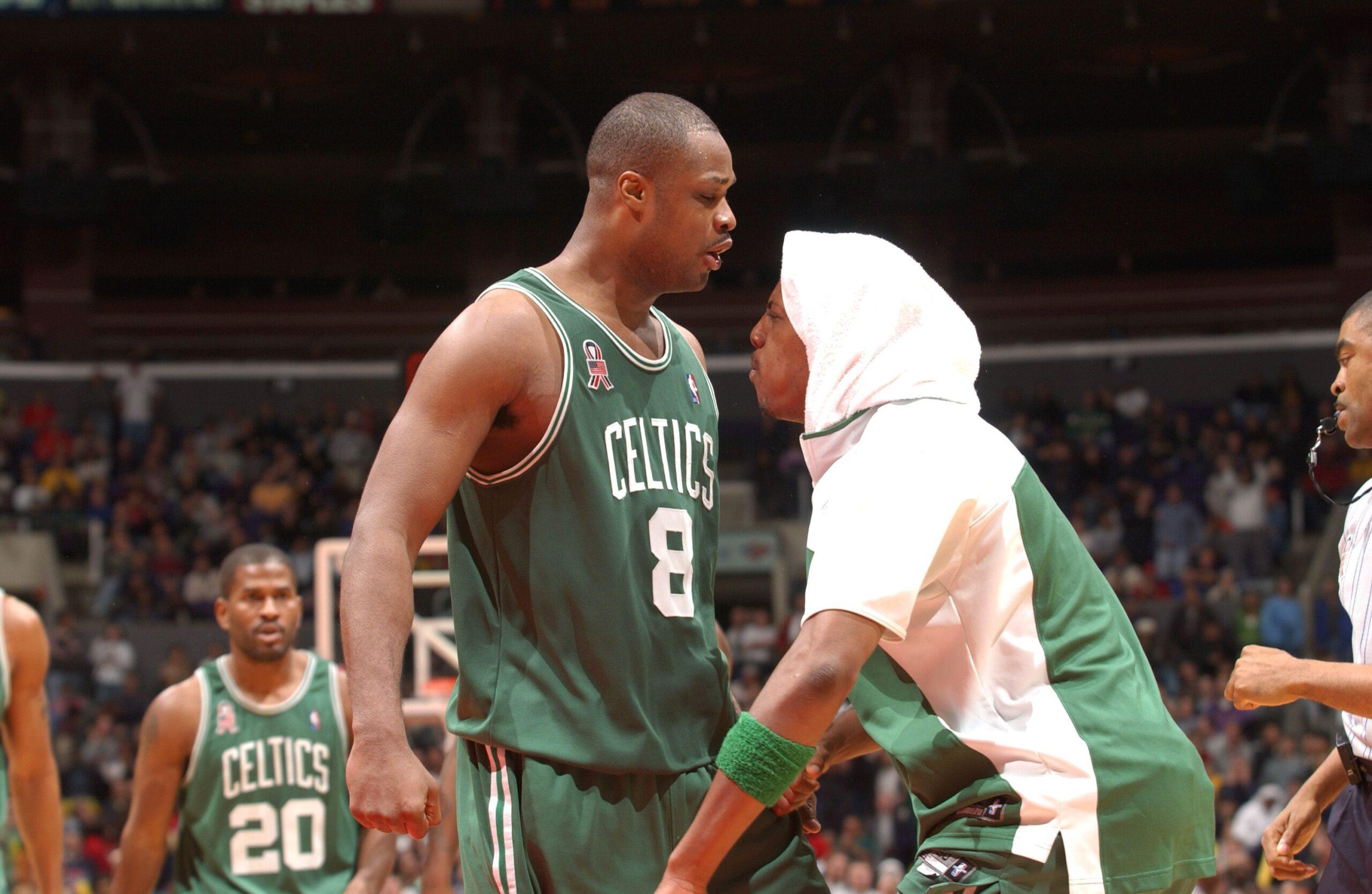
15. 2000-01 Celtics
Big Two: Paul Pierce, 25.3 ppg; Antoine Walker, 23.4 ppg
Adjusted Average: 25.60
Team Result: 36-46, missed playoffs
The early-aughts Celtics were ahead of their time; in 2000-01, Pierce and Walker combined to attempt 12.1 3s per game by themselves, which nearly equaled the league average of 13.7 per team. The duo shot them well, too, canning their 3s at a 37 percent clip. No other Celtic averaged even 10 points per game, however, and Rick Pitino resigned as coach and team president midway through the season.
14. 1961-62 Warriors
Big Two: Wilt Chamberlain, 50.4 ppg; Paul Arizin, 21.9 ppg
Adjusted Average: 25.67
Team Result: 49-31, lost in second round
Without the era adjustment, these Warriors would rank second on the list. But 1961-62 is the highest-scoring season in NBA history. Teams averaged more than 118 points per game, so even Chamberlain’s record output can’t propel this duo any higher. Even with a 50-points-per-game scorer, the Warriors were closer to a .500 record than first place, and they eventually lost by two points in a Game 7 in Boston.
13. 2005-06 76ers
Big Two: Allen Iverson, 33.0 ppg; Chris Webber, 20.2 ppg
Adjusted Average: 25.87
Team Result: 38-44, missed playoffs
Iverson won four scoring titles in his career, but not in 2005-06, his highest-scoring season, as Kobe Bryant bested him with a 35-per-game effort. On talent alone, this should have been a good 76ers team: the roster included Iverson, Webber, and young versions of Kyle Korver and Andre Iguodala. But the 76ers were a defensive disaster in coach Maurice Cheeks’s first season and missed the playoffs. It was Iverson’s last full season in Philly.
12. 2012-13 Thunder
Big Two: Kevin Durant, 28.1 ppg; Russell Westbrook, 23.2 ppg
Adjusted Average: 25.93
Team Result: 60-22, lost in second round
We’ll have more to say about the NBA’s most recent Big Two when Durant and Westbrook appear later on.
11. 2007-08 Nuggets
Big Two: Allen Iverson, 26.4 ppg; Carmelo Anthony, 25.7 ppg
Adjusted Average: 26.06
Team Result: 50-32, lost in first round
Iverson and Anthony stand out historically when contrasted with the rest of the fallow period that was the mid-aughts NBA. Between the dissolution of the Shaq–Kobe partnership in L.A. and the formation of the James–Wade titan in Miami, the two Nuggets were the only pair of teammates to each average 25 points per game in a season. The veteran Iverson was enjoying his last good season, while the younger Anthony was still ascending—he’d win his first Olympic gold later that summer. Together, the duo ranked third and fourth, respectively, in per-game scoring that season. But with Iverson, never an efficient scorer, as the lead ball handler, Denver didn’t run the best offense and ranked first in the NBA in pace but just ninth in points per 100 possessions. That inefficiency reared further in the playoffs, when the Lakers held Denver to 43 percent shooting (including 25 percent from 3) across a four-game sweep, in which three of the games were double-digit blowouts.
10. 1962-63 Lakers
Big Two: Elgin Baylor, 34.0 ppg; Jerry West, 27.1 ppg
Adjusted Average: 26.14
Team Result: 53-27, lost in Finals
9. 1964-65 Lakers
Big Two: Jerry West, 31.0 ppg; Elgin Baylor, 27.1 ppg
Adjusted Average: 26.16
Team Result: 49-31, lost in Finals
Even in the context of the high-scoring ’60s, West and Baylor rate high on this list, and they emerge as the NBA’s first great Big Two. Both Hall of Famers spent their entire career with the Lakers, and that inertia—in large part due to different rules at the time, such as a lack of free agency—gives the pairing some achievements sure to be unmatched by any modern Big Two. For instance, for the first nine seasons they played together, West and Baylor ranked first and second on the Lakers in points per game.
West and Baylor also saw their playing peaks overlap in fairly neat order. When the former entered the league, the latter was 26 years old and entering the best stretch of his career; by the time he began to age out of his prime, West was ready to assume the lead role. This is an important factor in many of the best pairings on this list (and outside it, like with Jordan and Pippen or Stockton and Malone): Generally, the best superstar pairings see the two players meet at the height of their powers. Mid-20s Shaq was better suited to win a title with Bryant than 37-year-old Shaq was to win a title with LeBron. Ironically, the one exception to this notion for the new Big Twos is LeBron himself, who is entering his age-35 season while Davis, at 26, has prime years still to come.
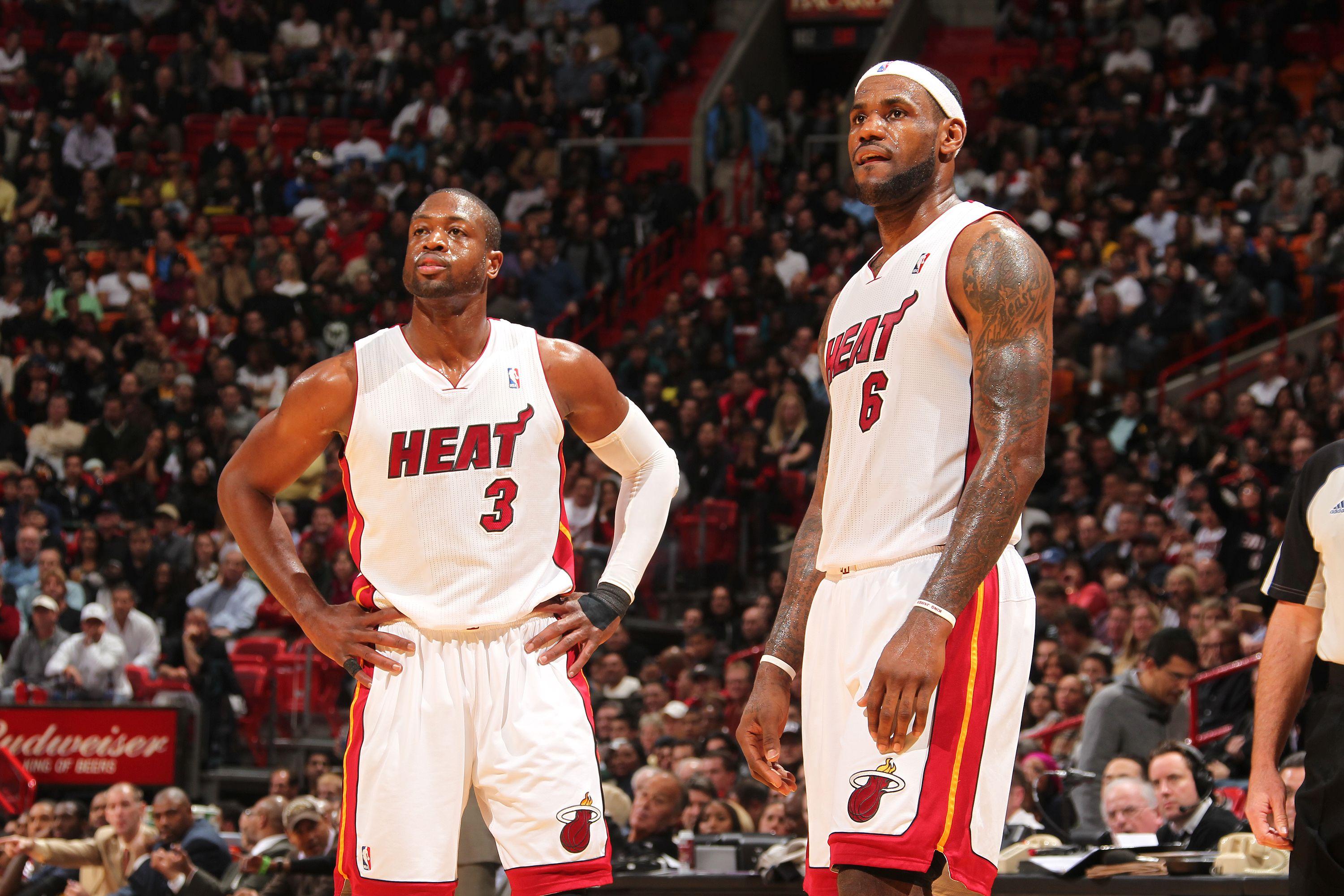
8. 2010-11 Heat
Big Two: LeBron James, 26.7 ppg; Dwyane Wade, 25.5 ppg
Adjusted Average: 26.22
Team Result: 58-24, lost in Finals
It might be a surprise that only two of the four star-laden teams in Miami this decade make this list, but during that four-season stretch, the Heat were at their least democratic early on; Wade in particular saw his scoring drop every year he played with James. The 2012-13 Heat, probably the best version of that team—they won 66 games, including 27 in a row, and beat the Spurs in a legendary Finals—rank 50th on the list of high-scoring duos, and the 2013-14 Heat rank 145th. The earliest, most lopsided Heat team wasn’t as successful, which underscores the broader trend of discovery in this piece: Supporting casts matter, too. In this case, Chris Bosh himself mattered. The Heat took a competitive leap in the 2011-12 playoffs when coach Erik Spoelstra nudged Bosh to center for most or all of his minutes, thus fulfilling the promise of their Big Three roster construction.
Chris Bosh’s Percentage of Minutes at Center
With Bosh at center, the Heat spaced the floor better and the offense flourished—even if the James and Wade combination wasn’t scoring quite as much. That’s another lesson for modern Big Twos, and one that LeBron and the Lakers would do well to note, given the shooting limitations that pervade L.A.’s roster.
7. 1999-00 Lakers
Big Two: Shaquille O’Neal, 29.7 ppg; Kobe Bryant, 22.5 ppg
Adjusted Average: 26.25
Team Result: 67-15, won championship
The first Shaq-Kobe title represents their first mutual appearance on this list, but far from the last.
6. 2011-12 Thunder
Big Two: Kevin Durant, 28.0 ppg; Russell Westbrook, 23.6 ppg
Adjusted Average: 26.61
Team Result: 47-19, lost in Finals
The Thunder qualified for this list for both 2011-12 and 2012-13, and they would have done so for 2013-14 and 2014-15 had Westbrook and Durant not suffered long-term injuries. No other recent duo comes close to that volume or longevity. The Thunder thrived with Westbrook and Durant dominating the offense.
Westbrook first crossed a 30 percent usage rate in 2010-11. Over that season and the next five, after which Durant left for Golden State, the Thunder ranked second in the NBA in regular-season wins (behind only the Spurs) and third in playoff wins (behind the Heat and Spurs). Even after foolishly trading Harden, they still could have won a title—and should have, frankly, if not for ill-timed injuries and Klay Thompson’s famous Game 6 explosion and, yes, the occasional awkwardness by which a “my turn, your turn” offense hampered a late-game possession.
The reunited Harden–Westbrook partnership in Houston might not work; most obviously, Westbrook’s career-long shooting struggles might interfere with his fit in Houston’s offense. But as Westbrook and Durant displayed for years in Oklahoma City, two high-volume scorers can coexist and prosper.
5. 2006-07 Nuggets
Big Two: Carmelo Anthony, 28.9 ppg; Allen Iverson: 24.8 ppg
Adjusted Average: 27.07
Team Result: 45-37, lost in first round
Iverson joined the Nuggets in a December 2006 trade and played 50 games for Denver that season, just enough to qualify for this list. The same issues afflicted the Nuggets in the first season of his pairing with Anthony as they did in the second, however, and the Nuggets lost a first-round playoff series in a rout. Fittingly enough, by 2008-09, they traded Iverson to Detroit for a more traditional point guard in Chauncey Billups—and promptly advanced to the conference finals, their longest playoff journey since they traded Vandeweghe more than two decades earlier.
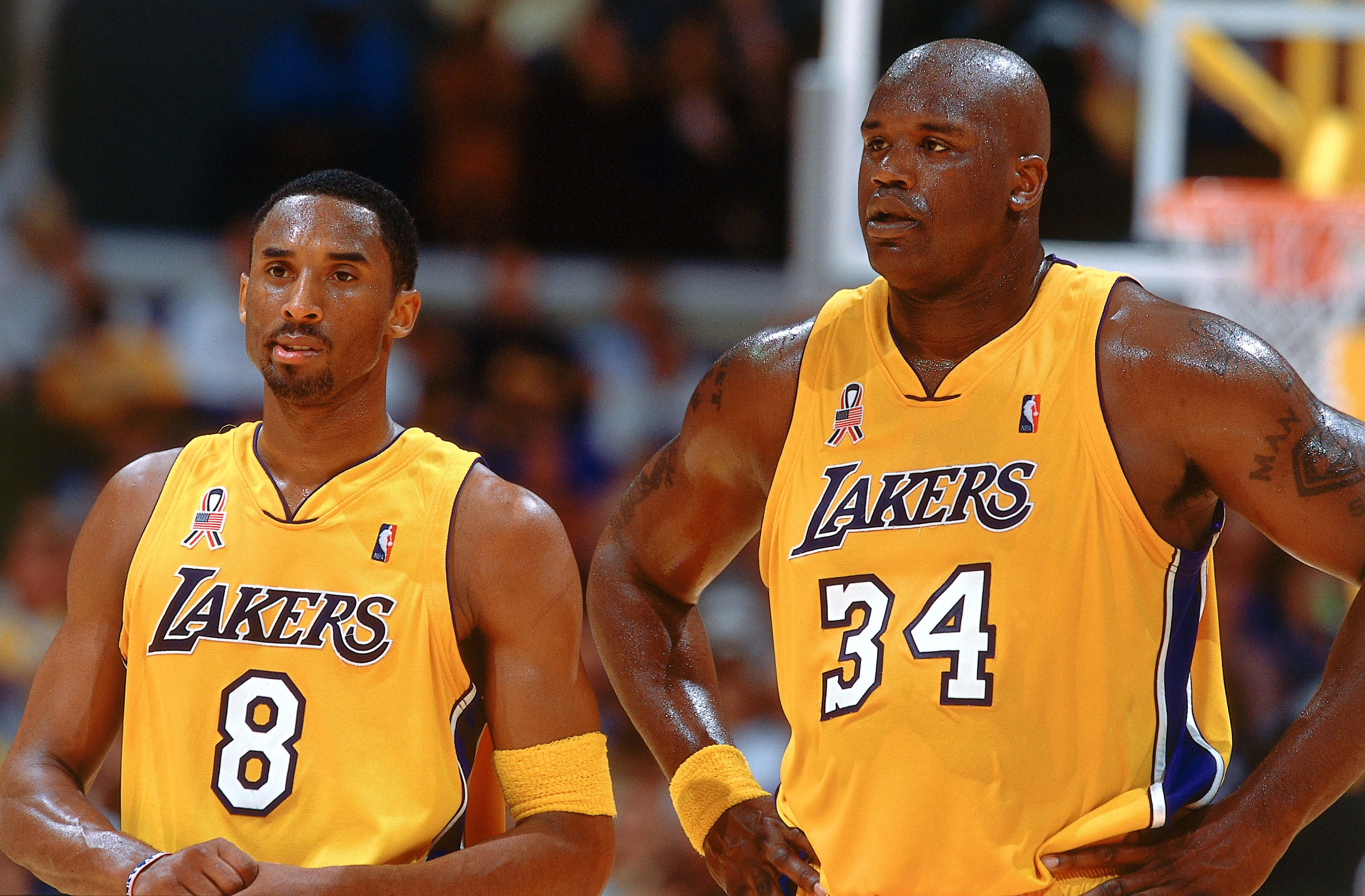
4. 2001-02 Lakers
Big Two: Shaquille O’Neal, 27.2 ppg; Kobe Bryant, 25.2 ppg
Adjusted Average: 27.41
Team Result: 58-24, won championship
More Shaq and Kobe, but there is yet more still to come.
3. 1961-62 Lakers
Big Two: Elgin Baylor, 38.3 ppg; Jerry West, 30.8 ppg
Adjusted Average: 28.72
Team Result: 54-26, lost in Finals
This spectacular Baylor season is the reason for the 48-game cutoff. Baylor missed nearly half of the season in 1961-62 because he was on Army Reserve duty and could play only when making use of weekend passes. But in the 48 games he did play, he averaged 38 points, 19 rebounds, and five assists per game—a combined threshold that no other NBA player has ever reached, military duty or not.
Had Baylor played enough games to qualify, his 1961-62 season would rank fourth all time on the points per game leaderboard, and first among everyone not named Wilt Chamberlain. As Bill Simmons wrote in The Book of Basketball, “I would argue that Elgin’s 38-19-5 was more implausible than Wilt’s 50 a game or Oscar’s triple-double. The guy didn’t practice! He was moonlighting as an NBA player on weekends! … Elgin’s 38-19-5 makes no sense. None. It’s inconceivable.”
Also inconceivable: Baylor and West are the only teammates in league history to each top the 30-ppg barrier. They’re not no. 1 on this list because of the aforementioned era adjustment. But any modern Big Two would be hard-pressed to equal this feat from more than half a century ago. Even Westbrook, to accommodate Paul George at his side, dropped his points per game from 32 the season before to just 25 and 23 in the two seasons with a new star teammate.
2. 2002-03 Lakers
Big Two: Kobe Bryant, 30.0 ppg; Shaquille O’Neal, 27.5 ppg
Adjusted Average: 30.17
Team Result: 50-32, lost in second round
1. 2000-01 Lakers
Big Two: Shaquille O’Neal, 28.7 ppg; Kobe Bryant, 28.5 ppg
Adjusted Average: 30.18
Team Result: 56-26, won championship
Shaq and Kobe so thoroughly dominated this ranking that they finished with the top two spots—and three of the top four, and four of the top seven. And nobody else is even close. Even before adjusting for era, these two seasons would rank in the top 10 all time; accounting for the muted scoring environment of the early 2000s—besides the abbreviated lockout season of 1998-99, the early 2000s contained the NBA’s lowest-scoring seasons since the 1950s—boosts them way above any competitor.
The four Shaq-Kobe Lakers squads on this list were incredibly successful, moreover, winning three titles and at times romping through the postseason in historic fashion. The top team here, in 2000-01, won every playoff game but one en route to the trophy. Their triumphs, both at the time and in this ranking, provide some final lessons for the NBA’s new Big Twos.
The first takeaway from this broader study is that even teams that generate bushels of points from just two players can flop in the standings. Just four of the top 20 teams on this list won the title (and three of those four involved the same two players), while eight of the 20 either missed the playoffs or lost in the first round. Overall, the correlation between a team’s regular-season winning percentage and its adjusted two-person scoring average was just 0.38, on a scale from 0 to 1. For reference, the correlation for the league-adjusted scoring average of only the top scorer is 0.33—meaning that knowing the relative quality of the second scorer doesn’t add much value beyond knowing the relative quality of the leader.
One of the four of Big Two teams to win a title—the 2011-12 Heat—really had a Big Three. Other high-scoring Big Twos ran into problems with inefficiency, depth, and defense. That’s a potential concern for a team like the current-day Lakers, who stripped their roster to acquire Davis, and potentially promising news for the Clippers, who maintained their depth and improved their defense while acquiring George and Leonard.
On the other hand, every new Big Two may be encouraged by the success of the early-aughts Lakers. Shaq and Kobe were two of the elite players of their time. But it would have been hard to argue that, say, Stackhouse and Hill, or Iverson and Webber, were two of the league’s top dozen players. The Big Twos whose teams performed the best were those with extreme top-end talent, and the new Big Twos in the NBA are stacked accordingly. That’s the good news.
The bad is that Shaq and Kobe succeeded in part because they were basically the lone notable Big Two of their time. The only other teams from the early aughts to appear on this list are the underperforming Celtics and Pistons, and the best duo from the Western Conference during that time were the Kings, who pushed the Lakers almost to a breaking point in the playoffs, but didn’t make the top 20. The new Big Twos won’t have the luxury of automatically having the two best players in any given postseason series; the star talents might approximate each other and just even out across the field. When everyone has a Big Two, then nobody does, and it really might be the rest of the roster that determines which team has the advantage.
